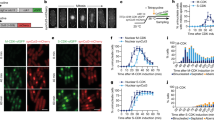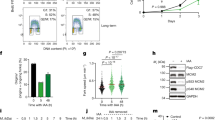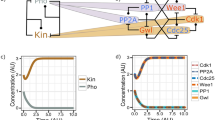Abstract
IN somatic cells, entry into mitosis depends on the completion of DNA synthesis. This dependency is established by S-phase feed-back controls that arrest cell division when damaged or unreplicated DNA is present1. In the fission yeast Schizosaccharomyces pombe, mutations that interfere with the phosphorylation of tyrosine 15 (Y15) of p34cdc2, the protein kinase subunit of maturation promoting factor, accelerate the entry into mitosis and abolish the ability of unreplicated DNA to arrest cells in G2 (ref. 2). Because the tyrosine phosphorylation of p34cdc2 is conserved in S. pombe3, Xenopus4, chicken5 and human6cells, the regulation of p34cdc2-Y15 phosphorylation could be a universal mechanism mediating the S-phase feedback control and regulating the initiation of mitosis7,8. We have investigated these phenomena in the budding yeast Saccharomyces cerevisiae. We report here that the CDC28 gene product (the S.cerevisiae homologue of cdc2) is phosphorylated on the equivalent tyrosine (Y19) during S phase but that mutations that prevent tyrosine phosphorylation do not lead to premature mitosis and do not abolish feedback controls. We have therefore demonstrated a mechanism that does not involve tyrosine phosphorylation of p34 by which cells arrest their division in response to the presence of unreplicated or damaged DNA. We speculate that this mechanism may not involve the inactivation of p34 catalytic activity.
This is a preview of subscription content, access via your institution
Access options
Subscribe to this journal
Receive 51 print issues and online access
$199.00 per year
only $3.90 per issue
Buy this article
- Purchase on SpringerLink
- Instant access to full article PDF
Prices may be subject to local taxes which are calculated during checkout
Similar content being viewed by others
References
Hartwell, L. H. & Weinert, T. A. Science 246, 629–634 (1989).
Enoch, T. & Nurse, P. Cell 60, 665–673 (1990).
Gould, K. L. & Nurse, P. Nature 342, 39–45 (1989).
Solomon, M. J., Glotzer, M., Lee, T. H., Philippe, M. & Kirschner, M. W. Cell 63, 1013–1024 (1990).
Krek, W. & Nigg, E. A. EMBO J. 10, 305–316 (1991).
Dracetta, G. et al. Nature 336, 738–744 (1988).
Nurse, P. Nature 344, 503–508 (1990).
Enoch, T. & Nurse, P. Cell 65, 921–923 (1991).
Field, J. et al. Molec. cell. Biol. 8, 2159–2165 (1988).
Krek, W. & Nigg, E. A. EMBO J. 10, 3331–3341 (1991).
Weinert, T. A. & Hartwell, L. H. Science 241, 317–322 (1988).
Russell, P. & Nurse, P. Cell 45, 145–153 (1986).
Dunphy, W. G. & Kumagai, A. Cell 67, 189–196 (1991).
Gautier, J., Solomon, M. J., Booher, R. N., Bazan, J. F. & Kirschner, M. W. Cell 67, 197–211 (1991).
Lundgren, K. et al. Cell 64, 1111–1122 (1991).
Russell, P., Moreno, S. & Reed, S. I. Cell 57, 295–303 (1989).
Hartwell, L. H. Bact. Rev. 38, 164–198 (1974).
Edgar, B. A. & O'Farrell, P. H. Cell 62, 469–480 (1990).
Amon, A., Surana, U., Muroff, I. & Nasmyth, K. Nature 355, 368–371 (1992).
Osmani, A. H., McGuire, S. L. & Osmani, S. A. Cell 67, 283–291 (1991).
Russell, P. & Nurse, P. Cell 49, 559–567 (1987).
Surana, U. et al. Cell 65, 145–161 (1991).
Druker, B. J., Mamon, H. J. & Roberts, T. M. New Engl. J. Med. 321, 1383–1391 (1989).
Author information
Authors and Affiliations
Rights and permissions
About this article
Cite this article
Sorger, P., Murray , A. S-phase feedback control in budding yeast independent of tyrosine phosphorylation of P34cdc28. Nature 355, 365–368 (1992). https://doi.org/10.1038/355365a0
Received:
Accepted:
Issue Date:
DOI: https://doi.org/10.1038/355365a0
This article is cited by
-
A comprehensive, mechanistically detailed, and executable model of the cell division cycle in Saccharomyces cerevisiae
Nature Communications (2019)
-
Budding yeast Wee1 distinguishes spindle pole bodies to guide their pattern of age-dependent segregation
Nature Cell Biology (2017)
-
Multi-step control of spindle pole body duplication by cyclin-dependent kinase
Nature Cell Biology (2001)
-
The role of Cdc25 phosphatases in cell cycle checkpoints
Protoplasma (2000)
-
p53 inhibits entry into mitosis when DNA synthesis is blocked
Oncogene (1999)




